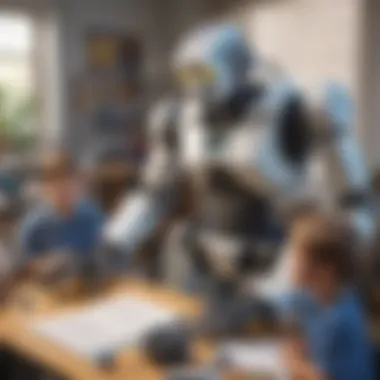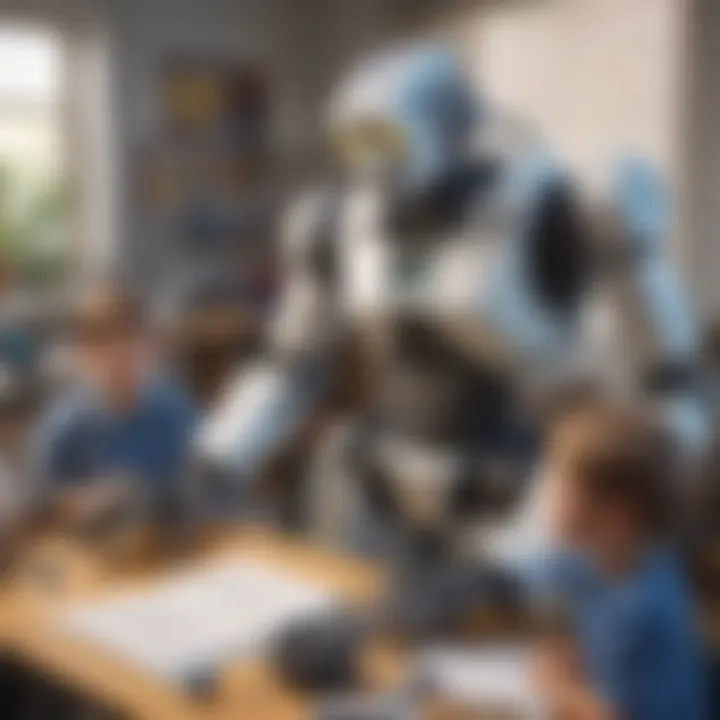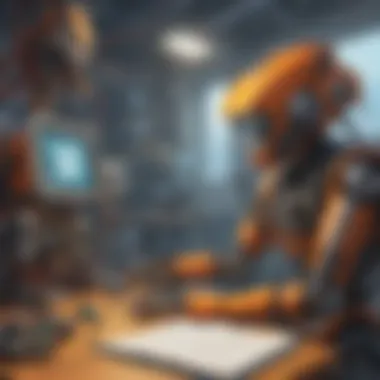Unleashing the Power of Robotics: Lessons for Young Science Enthusiasts


Science Fun Facts
Robots have been used in various industries, from manufacturing to healthcare, showcasing their versatility and adaptability to different tasks. Did you know that robots can also be programmed to interact with humans in a friendly and helpful manner? Imagine having a robot companion to assist with everyday tasks!
Discover the Wonders of Science
Embark on a journey to explore the fascinating world of robotics and its countless applications. Dive into interactive learning tools that showcase the principles of robotics in action. Watch educational videos and animations that bring complex scientific concepts to life, making learning engaging and accessible for young minds.
Science Quiz Time
Challenge your knowledge with interactive quizzes designed to test your understanding of robotics and related scientific principles. Engage in brain teasers and puzzles that stimulate critical thinking and problem-solving skills. Discover the fun of learning through gamification, where education meets entertainment in a stimulating and immersive way.
Science Experiment Showcase
Delve into hands-on learning with fun and engaging robotics experiments. Follow step-by-step instructions to build and program your own mini robot, exploring the fundamentals of robotics in a safe and engaging manner. Gather your materials list and learn essential safety tips and precautions to ensure a successful and enjoyable experiment.
Introduction to Robotics Education
Robotics education is a crucial foundation for young science enthusiasts, providing them with vital skills and knowledge in a rapidly advancing technological world. In this article, we will explore the fundamental concepts, benefits, and considerations related to introducing robotics to children aged 6-12. Understanding the basics of robotics lays the groundwork for nurturing curiosity, problem-solving abilities, and a passion for innovation among young learners.
Understanding the Basics
Definition and Significance of Robotics
The definition and significance of robotics encompass the creation and operation of robots to perform various tasks autonomously or through remote control. In the educational realm, this concept introduces children to technological advancements and automation. Robotics, with its emphasis on artificial intelligence and mechanical structures, offers a unique learning platform for kids. Its interdisciplinary nature bridges science, technology, engineering, and mathematics (STEM) fields, making it a valuable choice in enhancing young minds' cognitive development.


Evolution of Robotics in Education
The evolution of robotics in education highlights the integration of robotics to enhance the traditional learning experience. This inclusion exposes students to practical applications, fostering a deeper understanding of theoretical concepts through hands-on activities. By incorporating robotics in education, students are better equipped to grasp complex scientific principles and engage in critical thinking. While the evolution of robotics presents exciting opportunities for interactive learning, it also challenges educators to adapt teaching methodologies to meet the evolving needs of tech-savvy young learners.
Educational Benefits
Enhancing Problem-Solving Skills
Enhancing problem-solving skills through robotics engages children in real-world scenarios that require innovative solutions. By tackling challenges in a structured environment, students develop analytical thinking and creativity. This process not only sharpens problem-solving abilities but also instills resilience and teamwork as students collaborate to design and optimize robotic systems.
Developing Critical Thinking Abilities
Developing critical thinking abilities is a fundamental aspect of robotics education. Encouraging students to analyze problems from multiple perspectives fosters intellectual growth and insightful decision-making. Through experimentation and iterative design processes, children learn to evaluate outcomes, adapt strategies, and refine their approaches—an essential skill set for navigating dynamic technological advancements.
Fostering Creativity and Innovation
Fostering creativity and innovation in young learners is a critical outcome of robotics education. By encouraging imagination and experimentation, robotics empowers students to think outside the box and explore unconventional solutions. This creative freedom nurtures a culture of innovation, inspiring the next generation of inventors and problem solvers to push boundaries and shape the future.
Integration in Curricula
Robotic Curriculum Structures
Robotic curriculum structures offer a comprehensive framework for incorporating robotics into educational settings. By outlining clear learning objectives and progression pathways, these structures guide students through sequential skill development and project-based learning. The systematic approach ensures that children receive a well-rounded education in robotics, covering fundamental theories, practical applications, and ethical considerations.
Incorporating Robotics across Subjects
Incorporating robotics across subjects promotes interdisciplinary learning and strengthens the connection between theoretical concepts and practical applications. By integrating robotics themes into various subject areas such as science, mathematics, and even humanities, educators provide students with a holistic understanding of how technology shapes society. This cross-disciplinary approach cultivates versatile learners who can adapt their robotics knowledge to diverse academic disciplines and real-world challenges.


Practical Applications of Robotics
In this section, we delve into the crucial role of practical applications of robotics in fostering the development of young science enthusiasts. The concept of hands-on learning through robotics not only enhances problem-solving skills in children but also nurtures critical thinking abilities and promotes innovative thinking. By engaging in practical robotics projects, kids aged 6-12 can gain valuable experience in applying theoretical knowledge to real-world scenarios. This section aims to highlight the significance of hands-on experiences in sparking curiosity and passion for STEM subjects among the younger generation.
Real-World Examples
Robotics in Medicine
The integration of robotics in medicine revolutionizes the healthcare industry by offering precision and accuracy in surgical procedures. Robotics assist surgeons in performing complex operations with enhanced dexterity and minimal invasiveness, leading to faster recovery times for patients. The ability of medical robots to access difficult-to-reach areas within the human body underscores their crucial role in modern healthcare practices. While the automation of certain medical processes streamlines operations, it is essential to ensure proper training and maintenance of robotic systems to mitigate potential risks and ensure patient safety.
Robotics in Industry
Within the industrial sector, robotics automation facilitates optimized production processes, contributing to increased efficiency and reduced human error. Industrial robots aid in tasks that are hazardous or monotonous for humans, enhancing workplace safety and overall productivity. The ability of robots to operate continuously without fatigue ensures consistent output levels, making them indispensable for various manufacturing operations. However, ensuring the seamless integration of robotics into existing production lines requires adept programming and operational supervision to maximize benefits and minimize disruptions.
Robotics in Space Exploration
The utilization of robotics in space exploration plays a fundamental role in advancing scientific research and exploration beyond Earth's atmosphere. Robots deployed in space missions enable the collection of data in harsh environments without risking human lives, paving the way for groundbreaking discoveries and technological advancements. The autonomy and adaptability of space robots allow for prolonged missions and versatile scientific experiments, expanding our understanding of the universe. Despite the numerous advantages of robotic missions to space, challenges such as communication delays and system malfunctions underscore the need for continuous innovation and technological advancements in this field.
Hands-On Projects
Building and Programming Robots
Engaging in hands-on projects involving building and programming robots offers children a platform to apply theoretical knowledge in a practical setting. By constructing robots from scratch and coding them to perform specific tasks, young learners develop key skills such as problem-solving, logical reasoning, and attention to detail. The tactile experience of assembling components and troubleshooting potential errors helps cultivate a sense of accomplishment and resilience in facing technological challenges. However, ensuring proper guidance and supervision during robotics projects is essential to prevent frustration and maintain a positive learning environment.
Robotics Competitions and Challenges


Participating in robotics competitions and challenges provides children with an opportunity to showcase their skills, creativity, and teamwork abilities. These competitive events foster a spirit of collaboration and innovation among young participants, encouraging them to think outside the box and devise unique robotic solutions. The challenge of meeting specific tasks and overcoming obstacles in a timed setting enhances participants' decision-making skills and ability to work under pressure. While competitions offer a platform for friendly rivalry and skill development, emphasizing sportsmanship and learning from both successes and failures remains paramount.
Career Opportunities
Exploring STEM Professions
Exploring STEM professions through robotics education exposes children to diverse career paths in science, technology, engineering, and mathematics. By engaging in hands-on robotics activities and projects, young learners can discover their interests and aptitudes in various STEM fields, laying the foundation for future educational and career choices. The interdisciplinary nature of STEM professions encourages critical thinking, creativity, and problem-solving skills, preparing individuals for dynamic and evolving job markets. However, fostering a strong foundation in STEM subjects during early education is crucial to cultivating a passion for lifelong learning and professional growth.
Future Prospects in Robotics
The evolving landscape of robotics presents extensive opportunities for future career prospects and technological advancements. As industries increasingly adopt automation and AI technologies, the demand for skilled robotics professionals continues to grow across various sectors. The integration of robotics in fields such as healthcare, manufacturing, and space exploration underscores the critical role of robotics in shaping the future workforce. Emphasizing the development of interdisciplinary skills, adaptability, and continuous learning equips individuals to navigate the dynamic landscape of robotics careers successfully. While the future of robotics holds immense potential for innovation and progress, staying attuned to emerging trends and advances is essential for aspiring robotics enthusiasts to thrive in this ever-evolving field.
Interactive Robotics Activities
Interactive Robotics Activities are a fundamental aspect of this article, emphasizing hands-on learning experiences for young science enthusiasts. These activities play a crucial role in fostering curiosity and exploration among children aged 6-12. By engaging in Interactive Robotics Activities, kids can enhance their problem-solving skills, critical thinking abilities, and creativity. The interactive nature of these activities provides a dynamic learning environment where children can apply theoretical knowledge to practical scenarios, promoting a deeper understanding of robotics concepts.
Engaging Experiments
-##### Robotics Kits for Kids Robotics Kits for Kids are an integral part of hands-on learning in robotics education. These kits typically consist of components like motors, sensors, and building blocks that enable children to construct their robots. One key characteristic of Robotics Kits for Kids is their user-friendly design, making them accessible and engaging for young learners. The hands-on experience of building robots with these kits not only develops technical skills but also instills a sense of accomplishment in children as they see their creations come to life. Despite their advantages in promoting STEM learning, some kits may have limitations in terms of complexity or flexibility that could affect the scope of projects children can undertake.
-##### DIY Robotics Projects DIY Robotics Projects offer a creative outlet for young learners to experiment and innovate in robotics. Unlike pre-packaged kits, DIY projects encourage children to design and construct their robots from scratch, fostering a deeper understanding of engineering principles. The key characteristic of DIY Robotics Projects is their emphasis on customization and exploration, giving children the freedom to explore various design possibilities. While DIY projects promote creativity and innovative thinking, they may require more time and effort from both children and facilitators compared to using ready-made kits. However, the hands-on learning experience and problem-solving opportunities make DIY projects a valuable addition to robotics education.
Educational Tools and Resources
-##### Online Coding Platforms Online Coding Platforms provide a virtual space for children to learn programming skills essential in robotics. These platforms offer interactive tutorials, coding challenges, and project-based learning to enhance children's understanding of algorithms and logic. One key characteristic of Online Coding Platforms is their accessibility, allowing young learners to practice coding anytime and anywhere with internet access. The unique feature of real-time feedback on code performance enables children to iterate and improve their coding skills continuously. While online platforms offer convenience and structured learning, they may lack the hands-on aspect present in physical robotics activities.
-##### Virtual Robotics Simulations Virtual Robotics Simulations offer a simulated environment where children can design, program, and test robots virtually. These simulations provide a safe space for experimentation, allowing kids to explore robotics concepts without the constraints of physical materials. The key characteristic of Virtual Robotics Simulations is their interactive interface, enabling children to visualize code in action and debug errors effectively. The unique feature of scalability in simulations allows children to work on complex projects without the limitations of physical resources. While virtual simulations offer flexibility and reduce material costs, they may not provide the tactile experience that physical robotics activities offer.
Gamified Learning
-##### Robotics Apps for Children Robotics Apps for Children gamify the learning experience by incorporating interactive challenges and quests related to robotics concepts. These apps aim to engage young learners through gamified lessons and activities that make learning enjoyable and rewarding. The key characteristic of Robotics Apps is their user-friendly interface and engaging visuals, creating an immersive learning environment for children. The unique feature of progress tracking and rewards motivates children to advance in their learning journey while having fun. While robotics apps enhance engagement and retention of learning materials, they may require screen time management and supervision to ensure a balanced approach to technology use.
-##### Robotic Storytelling Workshops Robotic Storytelling Workshops combine robotics with narrative elements to stimulate children's creativity and storytelling skills. These workshops blend hands-on robot building with storytelling prompts, encouraging children to create interactive narratives using their robots. One key characteristic of Robotic Storytelling Workshops is their interdisciplinary approach, integrating STEM concepts with language arts and creativity. The unique feature of collaborative storytelling fosters teamwork and communication skills among participants. While these workshops promote imagination and narrative development, they may require facilitation to ensure a cohesive blend of robotics and storytelling elements.







